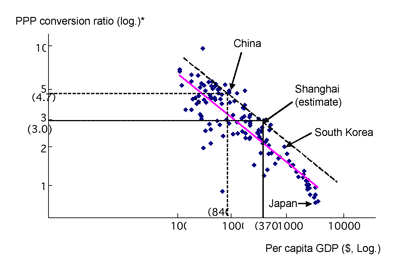August 21, 2002
China' s per capita gross domestic product (GDP) stood at a mere $911 in 2001, a far cry from Japan's $32,535. A comparison based on nominal GDP, however, may be biased, as the price level of China is far lower than that of Japan when both are measured in dollar terms. Misled by the mass media, many Japanese even have come to believe that China's coastal region centering on Shanghai - if not the whole nation - has approached Japan's level of economic development. Here, I would like to measure the real income level of China as a whole, its coastal region, and Shanghai, by taking purchasing power parity (PPP) into consideration.
Let me first explain the concept of PPP. When comparing per capita GDP of different countries, we do so in dollar terms based on nominal exchange rates, but the same dollar has different purchasing powers in different countries. Therefore, the per capita GDP so derived is overestimated for a country whose currency is strong so that its price level is high when measured in dollar terms, but underestimated for a country whose currency is weak so that its price level is low when translated into dollar terms. The idea of purchasing power parity, which attaches the same prices to the same goods and services regardless countries and regions, is useful in reducing this bias. By using PPP exchange rates instead of nominal rates, comparison of GDP can more accurately reflect the real income level of respective countries.
In its annual World Development Report, the World Bank provides PPP-based per capita GDP for countries across the globe, taking the price level in the US as the benchmark. According to the latest issue, China's per capita GDP in 2000 was $840 on a nominal basis, while its PPP-based per capita GDP was 4.7 times as high at $3,940. Thus in calculating the PPP-based per capita GDP figure for China, an exchange rate of 1.76 yuan to a dollar (the yuan's purchasing power parity), which is 4.7 times stronger than the market exchange rate of 8.28 yuan to a dollar, is used. In the case of Japan, PPP-based per capita GDP was $26,460 in 2000, substantially lower than the nominal figure of $34,210. When we compare nominal per capita GDP figures of the two countries, Japan is 40.7 times higher than China. The gap, however, comes down to 6.7 times when PPP-based figures are used.
Still, even taking PPP factors into account, China's position in the world does not change much. Of the 129 countries covered by the World Development Report, China ranked 76th on nominal basis and 68th on PPP basis, a modest climb. Because the gap by which the nominal exchange rate falls below the PPP exchange rates tends to be larger for a country whose income level is low than one whose income level is high, China and other developing countries have PPP-based GDP that is substantially higher than nominal GDP. Indeed, based on the World Bank's figures, PPP conversion ratios for China, South Korea, and Japan were 4.7, 1.9, and 0.8, respectively, with the figure inversely proportional to the level of per capita GDP. (See Figure)
Let us take a closer look at the coastal region of China. Based on China's official definition, the coastal region has a population of 527.1 million, with a per capita GDP of $1,454 in 2001. Per capita GDP of the richest 10 percent of Chinese population - those living in Shanghai, Beijing, Tianjin, Zhejiang, and part of Guangdong, which, as a whole, is roughly equivalent to Japan in terms of population size - came to $2,077, whereas per capita GDP in Shanghai alone was $3,706. Region-by-region PPP conversion rates are not available, but using the PPP conversion rate for the whole nation as a first approximation, per capita GDP came to $6,820 in the coastal region as officially defined, $9,742 for the richest 10 percent, and $17,378 in Shanghai.
Yet, the strong correlation between per capita income and the price level should also apply to various parts of China, which has large regional income disparities. Thus, the price level of Shanghai, which has the highest income level in China, should be substantially higher than other parts of the country. Based on the relation shown in the Figure, PPP-based per capita GDP is estimated at around $11,000 for Shanghai, compared with about $41,000 in Tokyo. So, even if we make comparison based on the assumption that both sides having the same price level, on average a resident in Shanghai, the most advanced city in China, is earning only one quarter that of an average Tokyo resident. Should the Japanese people still envy the Chinese for their growing prosperity?
Figure: PPP Conversion Ratio Inversely Proportional to Income Level
*PPP conversion ratio = PPP-based per capita GDP / Dollar-based per capita GDP Source: Compiled from World Bank, World Development Report 2002.
Author, C.H. Kwan
Senior Fellow
Research Institute of Economy, Trade and Industry (RIETI)
Editor-in-Chief, Ichiro Araki
Director of Research
Research Institute of Economy, Trade and Industry (RIETI)
e-mail: araki-ichiro@rieti.go.jp
tel: 03-3501-8248 fax: 03-3501-8416
RIETI invites you to visit its English website
[http://www.rieti.go.jp/en/index.html].
The opinions expressed or implied in this paper are solely those of the author, and do not necessarily represent the views of the Ministry of Economy, Trade and Industry (METI), or of the Research Institute of Economy, Trade and Industry (RIETI).

